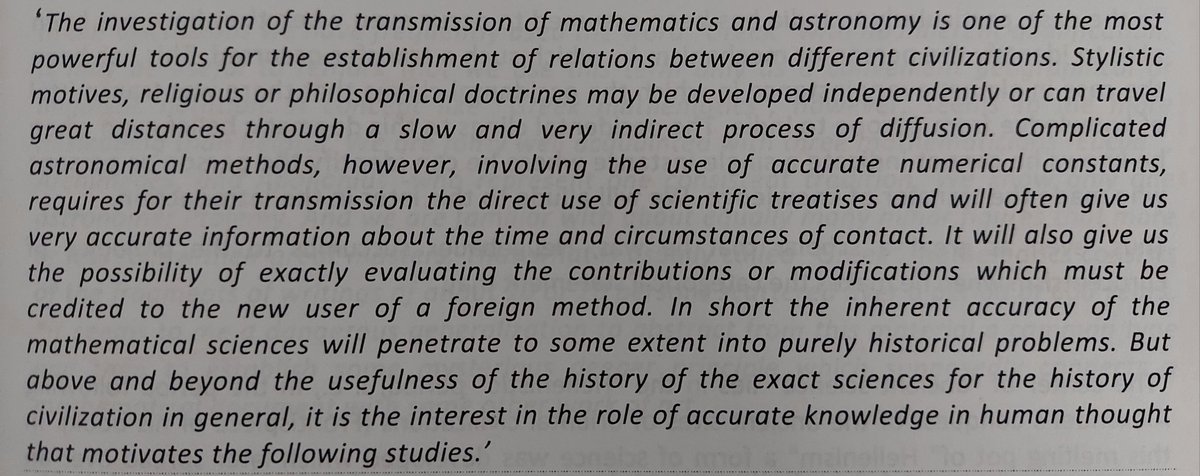
There were two great observatories in ancient India
Ujjain- Where the brightest minds gathered. Aryabhata, Brahmagupta, Bhaskara I & II, Vateshwara, all worked here
Mahodayapuram-Designed by Sankaranarayan~860AD, it boasted of many named instruments
But not one brick remains..
Ujjain- Where the brightest minds gathered. Aryabhata, Brahmagupta, Bhaskara I & II, Vateshwara, all worked here
Mahodayapuram-Designed by Sankaranarayan~860AD, it boasted of many named instruments
But not one brick remains..

The Avanti observatory was the single most important institution in the history of science.
Everything from the first trigonometric tables to heliocentric periods to principles of latitude & longitude determination came from here.
The zero degree meridian passed though Ujjain.
Everything from the first trigonometric tables to heliocentric periods to principles of latitude & longitude determination came from here.
The zero degree meridian passed though Ujjain.

With the path breaking results from Ujjain, Indian trade & agriculture thrived with accurate navigation & calendars.
Soon Arabs & Europeans acquired the techniques. Ujjain was destroyed and forgotten.
Only Maharaja Jai Singh II remembered. He rebuilt a small observatory in 1725
Soon Arabs & Europeans acquired the techniques. Ujjain was destroyed and forgotten.
Only Maharaja Jai Singh II remembered. He rebuilt a small observatory in 1725

The Tabqãt-i-Nãsirî by Abû Umr records the destruction of Ujjain by Iltutmish
There was a great bronze statue of Samraj Vikramaditya who founded the Vikrama era(57 BCE)used by astronomers.
Very likely it stood in the observatory
It was broken & taken to Delhi to be dishonoured
There was a great bronze statue of Samraj Vikramaditya who founded the Vikrama era(57 BCE)used by astronomers.
Very likely it stood in the observatory
It was broken & taken to Delhi to be dishonoured

Bhaskara became the head of the observatory. He died in 1185 CE.
We are lucky the Turks destroyed Ujjain only in 1233 CE
If he had died in their attack, science would have suffered a terrible blow. Even Madhava may not have invented calculus without the foundation laid by him.
We are lucky the Turks destroyed Ujjain only in 1233 CE
If he had died in their attack, science would have suffered a terrible blow. Even Madhava may not have invented calculus without the foundation laid by him.
The Aryabhata school of mathematicians were obsessed(for good reason)with trigonometric tables
Aryabhata's sine-difference table was precise to the 1st minute.
Varahamihira~575 CE improved it
Vateshvara~904 CE pushed its precision to the 2nd minute
The story continued in Kerala
Aryabhata's sine-difference table was precise to the 1st minute.
Varahamihira~575 CE improved it
Vateshvara~904 CE pushed its precision to the 2nd minute
The story continued in Kerala

The most ardent followers of Aryabhata were in Kerala, where multiple commentaries were produced. But the works of most early Kerala mathematicians are lost, partly or fully.
Haridatta~683CE
Govindaswami~830CE
Sankaranarayana~869CE
Jayadeva~950CE
Udayadivakara~1073CE
Haridatta~683CE
Govindaswami~830CE
Sankaranarayana~869CE
Jayadeva~950CE
Udayadivakara~1073CE

Govindaswami worked for Sthanu Ravi Kulasekhara(844-883 CE) the Chera emperor of Kerala, ruling from Mahodayapuram.
He attempted to improve the table to the 3rd minute-achieved by his distant successor Madhava
And he discovered the so called Newton-Gauss interpolation(2nd order)
He attempted to improve the table to the 3rd minute-achieved by his distant successor Madhava
And he discovered the so called Newton-Gauss interpolation(2nd order)
Govindaswami's disciple was Sankaranarayana. This visionary man built a grand observatory in Mahodayapuram, south India's first.
Known as the 'Ravi Varma Yantra Valayam', it was spectacular, fully equipped with the best of instruments-
Rasi Chakra
Jalesa Sutra
Golayantra etc
Known as the 'Ravi Varma Yantra Valayam', it was spectacular, fully equipped with the best of instruments-
Rasi Chakra
Jalesa Sutra
Golayantra etc

Sankaranarayana took time keeping very seriously.
At the passing of every Ghatika(24 mins) or half a muhurta as notified from the Yantravalayam, the soldiery were trained to ring a series of bells(kootu) all over Mahodayapuram to inform the public of the correct time.
At the passing of every Ghatika(24 mins) or half a muhurta as notified from the Yantravalayam, the soldiery were trained to ring a series of bells(kootu) all over Mahodayapuram to inform the public of the correct time.
When not being plundered by Sakas, Afghans, Turks or Huns, Indians were destroying each other.
Mahodayapuram was captured & burnt down by the Cholas under Rajendra Chola in the first half of the 11th century.
By the end of that century, Rama Varma shifted the capital to Kollam
Mahodayapuram was captured & burnt down by the Cholas under Rajendra Chola in the first half of the 11th century.
By the end of that century, Rama Varma shifted the capital to Kollam
Read-
Cultural foundations by CKR
Encyclopaedia of the History of Science, Technology & Medicine by H Selin
History of Kerala school of Hindu Astronomy by K.V Sharma
www-history.mcs.st-andrews.ac.uk
Kerala state Gazetteer Vol II by K. R Nair
Historical geography of Valluvanad by R Varier
Cultural foundations by CKR
Encyclopaedia of the History of Science, Technology & Medicine by H Selin
History of Kerala school of Hindu Astronomy by K.V Sharma
www-history.mcs.st-andrews.ac.uk
Kerala state Gazetteer Vol II by K. R Nair
Historical geography of Valluvanad by R Varier
• • •
Missing some Tweet in this thread? You can try to
force a refresh





